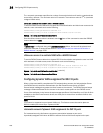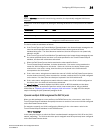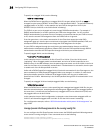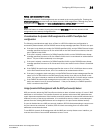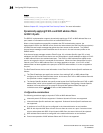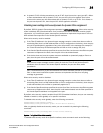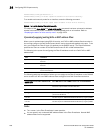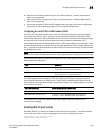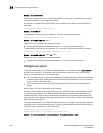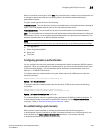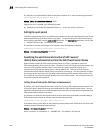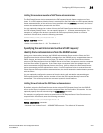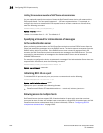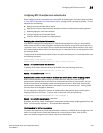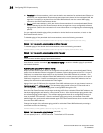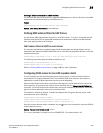
1238 PowerConnect B-Series FCX Configuration Guide
53-1002266-01
Configuring 802.1X port security
34
Syntax: [no] dot1x-enable
At the dot1x configuration level, you can enable 802.1X port security on all interfaces at once, on
individual interfaces, or on a range of interfaces.
For example, to enable 802.1X port security on all interfaces on the device, enter the following
command.
PowerConnect(config-dot1x)#enable all
Syntax: [no] enable all
To enable 802.1X port security on interface 3/11, enter the following command.
PowerConnect(config-dot1x)#enable ethernet 3/11
Syntax: [no] enable ethernet <port>
Specify the <port> variable in the following formats:
• PowerConnect B-Series FCX stackable switches – <stack-unit/slotnum/portnum>
To enable 802.1X port security on interfaces 3/11 through 3/16, enter the following command.
PowerConnect(config-dot1x)#enable ethernet 3/11 to 3/16
Syntax: [no] enable ethernet <port> to <port>
Specify the <port> variable in the following formats:
• PowerConnect B-Series FCX stackable switches – <stack-unit/slotnum/portnum>
Setting the port control
To activate authentication on an 802.1X-enabled interface, you specify the kind of port control to
be used on the interface. An interface used with 802.1X port security has two virtual access
points: a controlled port and an uncontrolled port:
• The controlled port can be either the authorized or unauthorized state. In the authorized state,
it allows normal traffic to pass between the Client and the Authenticator. In the unauthorized
state, no traffic is allowed to pass.
• The uncontrolled port allows only EAPOL traffic between the Client and the Authentication
Server.
Refer to Figure 155 for an illustration of this concept.
By default, all controlled ports on the device are in the authorized state, allowing all traffic. When
you activate authentication on an 802.1X-enabled interface, its controlled port is placed in the
unauthorized state. When a Client connected to the interface is successfully authenticated, the
controlled port is then placed in the authorized state. The controlled port remains in the authorized
state until the Client logs off.
To activate authentication on an 802.1X-enabled interface, you configure the interface to place its
controlled port in the authorized state when a Client is authenticated by an Authentication Server.
To do this, enter commands such as the following.
PowerConnect(config)#interface e 3/1
PowerConnect(config-if-3/1)#dot1x port-control auto
Syntax: [no] dot1x port-control [force-authorized | force-unauthorized | auto]



